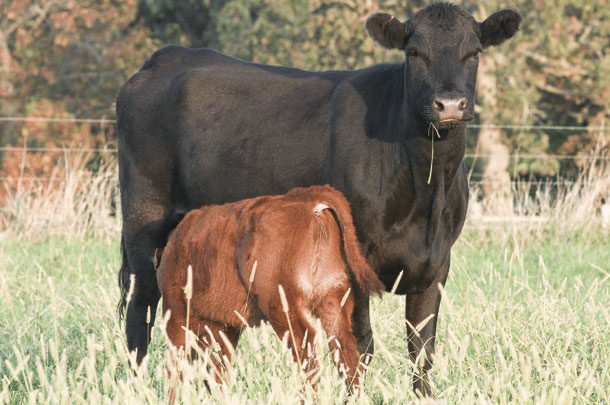The crux of good and balanced nutrition throughout a cow’s pregnancy is its impact on reproductive performance of the cow and overall health and performance throughout the life cycle of her unborn calf. In cow-calf operations, these factors can make or break you from a profitability standpoint.
Consequences of poor nutrition
Proper nutrition during a cow’s pregnancy is vital. It affects both the quantity and quality of colostrum, which is the foundation of a calf’s ability to thrive or falter. Quality colostrum boosts a calf’s immune system following birth, helping protect them from common health issues like scours. The USDA’s Animal and Plant Health Inspection Service (APHIS) 2015 report on death losses in U.S. cattle and calves indicated 9.6% of beef calf losses resulted from digestive problems including scours, bloat, parasites, enterotoxemia or acidosis. How much of this loss could be prevented if all calves were privy to high-quality colostrum immediately following birth?
Calf mortality aside, we observe calves from dams in poor nutrition through pregnancy simply struggling to perform all the way through their life cycle. These calves that get a bad start are less thrifty, don’t handle the stress of weaning and processing well, and are frankly more likely to face health challenges throughout their lives, costing you time and money. In my personal experience in the field, I’ve observed differences in weaning weights of up to 75 pounds per calf between calves from dams on a good plane of nutrition versus those cows with poor nutrition. In today’s market, that’s a significant amount of money lost.
Reproductive performance of your herd is the basis of economics of the cow-calf business. With an inadequate nutrition program (either too little or too much) for your cows, you’ll see reduced conception rates and the inability of every cow to have a calf every 12 months, which is essential to remain profitable.
Nutritional best practices
Understanding the potential negative consequences of poor nutrition for your cow herd is one thing, but doing something about it is another. So where do you start?
In cow-calf production systems, your forage supply should be your number one consideration. This includes both the quantity and quality of forage. Your local extension agent or feed representative can help you pull forage samples and analyze those to learn what is needed to balance the forage supply you have available.
The impact of seasonality on your forage supply and quality is something else to consider. For many operations, the last 90 days of a cow’s gestation cycle coincides with the period preceding the best forage supply. You cannot assume you have enough to get your herd by during this period, as the last 90 days of gestation is when rapid fetal growth takes place. Even the best grass farmers will likely struggle to deliver the energy levels needed due to the increased demand from both the cow and calf in this period with their forage alone.
Balance throughout gestation is the name of the game. A good mineral program, supplemental protein and energy when needed, and adequate forage supplies all work together to help you deliver the right nutrition for your herd. The National Research Council (NRC) Nutrient Requirements of Beef Cattle is the guidepost for the industry on what cows need in terms of vitamins, trace minerals, macrominerals, protein, energy and fiber. Meeting those requirements will be your best bet for optimizing cow and calf health with longevity in mind.
Other management considerations
Nutrition can’t be overlooked as an integral part of your management plan, but it’s not the only consideration to set your calves up for success following birth.
Ensure you have a good, clean source of water for your cattle. If feasible, move your cows into a clean and dry environment prior to calving, and consider the impact of group size on the comfort and socialization level of your herd.
Work with your veterinarian to develop a herd health plan, considering vaccination, parasite control and treatment protocols in the instance of disease.
Anything you can do to reduce social, environmental and nutritional stress prior to calving will contribute to the results you’re going to get from both the cow and calf performance-wise post-pregnancy. Do your herd and yourself a favor by starting your calves off on the right hoof. ![]()

-
Kendal Roweton
- Beef Technical Specialist
- Cargill Animal Nutrition
- Email Kendal Roweton








